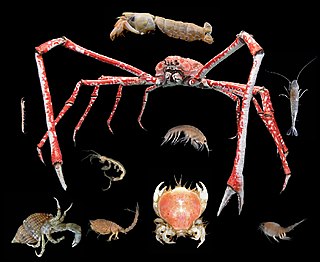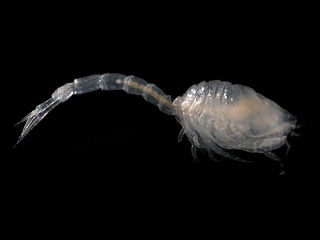
Malacostraca is the largest of the six classes of crustaceans, containing about 40,000 living species, divided among 16 orders. Its members, the malacostracans, display a great diversity of body forms and include crabs, lobsters, crayfish, shrimp, krill, prawns, woodlice, amphipods, mantis shrimp, tongue-eating lice and many other less familiar animals. They are abundant in all marine environments and have colonised freshwater and terrestrial habitats. They are segmented animals, united by a common body plan comprising 20 body segments, and divided into a head, thorax, and abdomen.

Cumacea is an order of small marine crustaceans of the superorder Peracarida, occasionally called hooded shrimp or comma shrimp. Their unique appearance and uniform body plan makes them easy to distinguish from other crustaceans. They live in soft-bottoms such as mud and sand, mostly in the marine environment. There are more than 1,500 species of cumaceans formally described. The species diversity of Cumacea increases with depth.

Diastylis is a genus of crustaceans which belong to the family Diastylidae. It includes the following species:

Diastylidae is one of the eight most commonly recognised families of crustaceans of the order Cumacea. They are marine creatures especially common around the 30th parallel north.
Ceratocumatidae is a family of crustaceans of the order Cumacea. Ceratocumatidae have a small free telson. The endopods of the uropods are present on only one segment. Males have 5, 4 or 3 pairs of pleopods. All maxillipeds and some of the pereiopods bear exopods. The gill apparatus has no supporting gill plates.
Gynodiastylidae is one of the eight most commonly recognised families of crustaceans of the order Cumacea. They are especially prevalent in the southern hemisphere, with some types described from Japan, Thailand and the Persian Gulf. Most are found at less than 100 metres (330 ft) depth.
Lampropidae is a family of cold-water crustaceans belonging to the order Cumacea. Members of Lampropidae are relatively easily recognised because they all at have at least three terminal setae on the telson. The telson is medium to large and not fused with the last segment of the pleon. The endopods of the uropods are present on all three members. In the males the flagellum of the second antenna reaches beyond the carapace; moreover, they possess pleopods. In the females the second antenna is somewhat shorter than the first. There are exopods on the third maxilliped and strongly reduced or absent on the third pereopods.

Leuconidae is a family of marine hooded shrimp. The family was established by Georg Ossian Sars in his 1878 study of Mediterranean cumaceans.

Nannastacidae is a family of crustaceans belonging to the order Cumacea. They have no free telson. The endopods of the uropods are present on one segment. There are exopods on the maxillipeds and generally one on pereopods 1–4 in males and 1–2 in females. In the females the second antenna is much shorter than the first. It contains the following genera:

Bodotria scorpioides is a species of crustacean belonging to the order Cumacea. They are found in the East Atlantic, the Mediterranean and the Black Sea. B. scorpioides does not possess a free telson. The first thoracic somite is too short to be seen from above, the second is longer. Both males and females have exopods on the first pereopods only.

Bodotria is a genus of crustaceans which belong to the family Bodotriidae. It includes the following species:

Iphinoe is a genus of crustaceans which belong to the family Bodotriidae. It includes the following species:
Nannastacus is a genus of crustaceans in the order Cumacea. It contains the following species:
Cyclaspis is a genus of cumacean crustaceans in the subfamily Bodotriinae, containing the following species:

Pseudocuma longicorne is a marine species of cumacean in the family Pseudocumatidae.

Pseudocuma is a genus of cumaceans, including the following species:

Campylaspis is a genus of crustaceans in the order Cumacea. Species of Campylaspis have a "bulky" carapace, which makes up more than 40% of the animal's length, as well as distinctive features of the mouthparts. There are currently 170 recognised described species:
Mihai Băcescu was a Romanian zoologist.
Zimmeriana is a genus of gynodiastylid cumacean. It is found from New South Wales to Western Australia, and in Japan. It contains 6 species, as of March, 2017.








